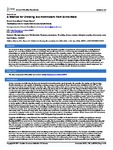A Method for Growing Bio-memristors from Slime Mold
| dc.contributor.author | Miranda, Eduardo | |
| dc.contributor.author | Braund, Edward | |
| dc.date.accessioned | 2018-03-05T13:15:55Z | |
| dc.date.available | 2018-03-05T13:15:55Z | |
| dc.date.issued | 2017-11-02 | |
| dc.identifier.issn | 1940-087X | |
| dc.identifier.issn | 1940-087X | |
| dc.identifier.uri | http://hdl.handle.net/10026.1/10935 | |
| dc.description.abstract |
Our research is aimed at gaining a better understanding of the electronic properties of organisms in order to engineer novel bioelectronic systems and computing architectures based on biology. This specific paper focuses on harnessing the unicellular slime mold Physarum polycephalum to develop bio-memristors (or biological memristors) and bio-computing devices. The memristor is a resistor that possesses memory. It is the 4th fundamental passive circuit element (the other three are the resistor, the capacitor, and the inductor), which is paving the way for the design of new kinds of computing systems; e.g., computers that might relinquish the distinction between storage and a central processing unit. When applied with an AC voltage, the current vs. voltage characteristic of a memristor is a pinched hysteresis loop. It has been shown that P. polycephalum produces pinched hysteresis loops under AC voltages and displays adaptive behavior that is comparable with the functioning of a memristor. This paper presents the method that we developed for implementing bio-memristors with P. polycephalum and introduces the development of a receptacle to culture the organism, which facilitates its deployment as an electronic circuit component. Our method has proven to decrease growth time, increase component lifespan, and standardize electrical observations. | |
| dc.format.extent | 56076- | |
| dc.format.medium | Electronic | |
| dc.language | en | |
| dc.language.iso | en | |
| dc.publisher | MyJove Corporation | |
| dc.subject | Biomimetics | |
| dc.subject | Electric Impedance | |
| dc.subject | Electrophysiological Phenomena | |
| dc.subject | Myxomycetes | |
| dc.title | A Method for Growing Bio-memristors from Slime Mold | |
| dc.type | journal-article | |
| dc.type | Journal Article | |
| dc.type | Video-Audio Media | |
| plymouth.author-url | https://www.ncbi.nlm.nih.gov/pubmed/29155754 | |
| plymouth.issue | 129 | |
| plymouth.volume | 2017 | |
| plymouth.publication-status | Published online | |
| plymouth.journal | Journal of Visualized Experiments | |
| dc.identifier.doi | 10.3791/56076 | |
| plymouth.organisational-group | /Plymouth | |
| plymouth.organisational-group | /Plymouth/Faculty of Arts, Humanities and Business | |
| plymouth.organisational-group | /Plymouth/Faculty of Arts, Humanities and Business/School of Society and Culture | |
| plymouth.organisational-group | /Plymouth/REF 2021 Researchers by UoA | |
| plymouth.organisational-group | /Plymouth/REF 2021 Researchers by UoA/UoA33 Music, Drama, Dance, Performing Arts, Film and Screen Studies | |
| plymouth.organisational-group | /Plymouth/Users by role | |
| plymouth.organisational-group | /Plymouth/Users by role/Academics | |
| dc.publisher.place | United States | |
| dcterms.dateAccepted | 2017-01-01 | |
| dc.rights.embargodate | 2021-12-3 | |
| dc.identifier.eissn | 1940-087X | |
| dc.rights.embargoperiod | Not known | |
| rioxxterms.versionofrecord | 10.3791/56076 | |
| rioxxterms.licenseref.uri | http://www.rioxx.net/licenses/all-rights-reserved | |
| rioxxterms.licenseref.startdate | 2017-11-02 | |
| rioxxterms.type | Journal Article/Review |


